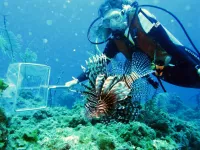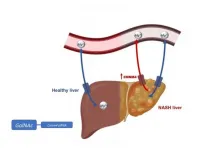Limiting invasive species may be a better goal than eliminating them
U of A biologist leads new study on "functional eradication" to curtail numbers of invasive species based on achievable targets for preventing ecological damage.
2021-03-04
(Press-News.org) Managing invasive species--not eliminating them altogether--is a better use of time and conservation resources in many cases, according to a study led by a University of Alberta biologist.
Every year, hundreds of introduced species cause billions of dollars in damage to ecosystems, agriculture and infrastructure in North America alone. The research, led by Stephanie Green, makes a case for working smarter, not harder, to temper the impact of destructive and widespread invasive species using a strategy called functional eradication.
"Rather than trying to completely eliminate invasive species that have spread over large areas, which is very challenging, functional eradication aims to limit their abundances below levels that damage the ecosystem in priority locations. Resources that might otherwise be wasted on attempting complete eradication can be spread to other areas, protecting more places from impacts," explained Green, assistant professor in the Department of Biological Sciences and Canada Research Chair in Aquatic Global Change Ecology and Conservation.
Green partnered with Edwin Grosholz, an ecologist in the Department of Environmental Science and Policy at the University of California, Davis, to survey 232 natural resource managers and invasive species specialists in Canada and the United States.
"More than 90 per cent of these folks said the most destructive invaders in their regions were spread beyond a scale at which they could eradicate them, and instead local teams were engaged in a long-term battle to suppress or contain the species," explained Green.
However, only two per cent said they had identified targets for when they had done enough to manage a species.
"This points to a major gap between the needs of the people who must make decisions about invasive species, and the information scientists and monitoring programs are collecting," said Grosholz.
Managing the impact
Managing widespread invasive species is a long-term endeavour, but not one without hope, Green explained.
"Involving local communities in the functional eradication process is essential for maintaining the capacity needed to continually suppress these invaders."
An example of functional eradication at work is invasive lionfish. The beautiful Indo-Pacific fish, which are popular in aquariums, have spread throughout the Caribbean Sea and the Atlantic Ocean, where they prey on many native species. They are now caught and consumed as food, and used in local art. The financial incentives for catching lionfish are also serving to reduce their population below levels that affect native species in the area.
Similar strategies can be applied to the European green crab, an invasive species found along the Pacific and Atlantic coasts in Canada and the United States, as well as Prussian carp, which is spreading throughout central Canada, including in Alberta's Bow River.
"Our study shows that ecologically damaging and widespread invasive species are prime candidates for functional eradication. To effectively keep populations down in priority areas, targets need to be based on how many of the invasive species it takes to cause major changes in the ecosystem," said Green.
INFORMATION:
This research was funded by the David H. Smith Conservation Research Program, the Natural Sciences and Engineering Research Council of Canada, the Pacific States Marine Fisheries Commission and the National Science Foundation. Collaborators include the United States Aquatic Nuisance Species (ANS) Task Force.
The study, "Functional eradication as a framework for invasive species control," was published on the cover of the March issue of Frontiers in Ecology and the Environment.
[Attachments] See images for this press release:

ELSE PRESS RELEASES FROM THIS DATE:
2021-03-04
Typically, light emitted from standard lasers has a controllable degree of freedom (DoF) which may be polarisation or beam shape. By suitably manipulating a laser with the introduction of specialised optical components, an output with 2 DoFs, such as vector vortex beams with controllable polarisation and orbital angular momentum (OAM). The term 'vector' describes a structured change in the polarisation across the beam and 'vortex' describes the twisting of the phase in the beam (OAM), much like a twisting tornado. Transcending 2 DoFs from a laser was not possible. By exploiting ray-wave duality in a frequency-degenerate laser, ...
2021-03-04
Being older, overweight and having low haemoglobin levels (fewer red blood cells) could increase a patient's risk of developing debilitating nerve damage following chemotherapy, a research team led by UNSW Sydney has revealed.
The researchers aimed to identify pre-treatment clinical and blood-based risk factors in patients who developed chemotherapy-induced peripheral neuropathy (CIPN) - nerve damage in peripheral body parts, like hands or feet, as a result of chemotherapy.
The study, published in JAMA Network Open recently, examined patients - mostly women - who received paclitaxel or oxaliplatin chemotherapy treatment, which are common treatments for breast, colorectal and gynaecological ...
2021-03-04
In a colourful solution to a dangerous problem, Australian scientists are adapting a component from cutting-edge solar cells to design a rapid, light-based detection system for deadly toxins.
While use of chemical warfare agents like sulfur mustard - better known as mustard gas - is banned internationally, we do rely on other strictly-controlled chemicals for agriculture, industry and throughout our daily lives, including fumigants like methyl iodide, which is used to control insects and fungi. The wrong amounts or incorrect use of these fumigants can be harmful to people and degrade the ozone layer.
Because it's invisible and doesn't smell, it's hard to tell whether there are dangerous amounts of methyl iodide present, and until ...
2021-03-04
An international team of researchers has identified the CNNM4 protein as a key regulator of magnesium in the liver and potential therapeutic target for non-alcoholic fatty liver disease, according to a study published in the Journal of Hepatology.
Non-alcoholic steatohepatitis, a form of fatty liver disease characterized by inflammation and liver fibrosis, is associated with obesity and has a worldwide prevalence of 1.7 billion people.
Unhealthy nutritional habits and dietary imbalances are recognized as causes of many diseases. Magnesium is widely available in both plant and animal foods; most vegetables, legumes, peas, beans, and nuts are rich in magnesium, as are some ...
2021-03-04
An exquisitely detailed global ocean model simulation from the National Center for Atmospheric Research (NCAR) has given scientists rare insight into where baby sea turtles may go in their "lost years" after they scramble off the sandy beaches where they are born and swim into the open ocean.
This look at a critically important period in the life cycle of endangered loggerhead turtles could help inform more comprehensive conservation efforts that encompass regions of the open ocean where young turtles grow, and not just the nesting beaches. It also pinpoints regions of the ocean that are important to study to better understand how to protect sea turtles. ...
2021-03-04
DALLAS, March 4, 2021 -- The rate of cardiovascular risk factors among Hispanic/Latino people living in the U.S. is very high, and while they are often aware of their health conditions, less than half of the Hispanic/Latino adults with history of stroke or transient ischemic attack (TIA) had healthy blood pressure and cholesterol, and about half had healthy blood sugar levels, according to new research published today in Stroke, a journal of the American Stroke Association, a division of the American Heart Association.
According to the American Heart Association, from 2015 to 2018, 52.3% of Hispanic men and 42.7% of Hispanic women aged 20 years and older had cardiovascular disease (CVD).
"It's a wake-up call for ...
2021-03-04
Bottom Line: Cancer survivors had a greater risk of reduced ambulatory function, which was associated with an increased risk of death.
Journal in Which the Study was Published: Cancer Epidemiology, Biomarkers & Prevention, a journal of the American Association for Cancer Research
Author: Elizabeth Salerno, PhD, MPH, assistant professor of surgery at Washington University School of Medicine in St. Louis, who conducted the research at the National Cancer Institute
Background: The diagnosis and treatment of cancer has been shown to be associated with poor functional health for common cancer types, such as those of the breast and prostate, but less is known about the association for other cancers, explained Salerno. "Given that cancer survivors are living longer than ever, ...
2021-03-04
A new study led by Washington University School of Medicine in St. Louis and the National Cancer Institute (NCI) has identified an association between slow walking pace and an increased risk of death among cancer survivors.
While the study does not establish that slow walking is a cause of death, the association persisted across at least nine tumor types. Investigators now call for more research into these relationships and whether targeted interventions such as physical activity programs could help cancer survivors improve their ability to walk and increase survival after cancer diagnosis and treatment.
The study, a collaboration between Washington University, the NCI of the ...
2021-03-04
The loss of seagrass in the waters around the UK is much higher than previously estimated. A new study published in Frontiers in Plant Science concludes that, with high certainty, at least 44% of the UK's seagrasses have been lost since 1936, of which 39% has been since the 1980s. This study is one of the first of its kind to bring together seagrass data from diverse sources and give a systematic estimate of the current and historic extent of seagrass, as well as seagrass loss in the UK.
The study was a collaboration between researchers at University College London, Kings College London, and Swansea University.
Seagrasses as climate change superheroes
Nature-based solutions are essential to mitigate the effects of the climate crisis, and seagrasses are highly ...
2021-03-04
(Boston)--Children in Zambia under age 5 die at a rate that is between nearly six to more than 10 times higher than those in the U.S; it is estimated at 40-75 per 1000, compared to 6.98 per 1000. Identifying why these children are dying is the mission of Rotem Lapidot, MD, assistant professor of pediatrics at Boston University School of Medicine (BUSM).
"Significantly, over 80 percent of all community infant deaths involved some form of delay. While it is impossible to know what would have occurred in the absence of such delays, the majority of infant deaths in Lusaka, the capital of Zambia, are from causes for which effective treatments currently exist," explained Lapidot, the corresponding author on the study ...
LAST 30 PRESS RELEASES:
[Press-News.org] Limiting invasive species may be a better goal than eliminating them
U of A biologist leads new study on "functional eradication" to curtail numbers of invasive species based on achievable targets for preventing ecological damage.




